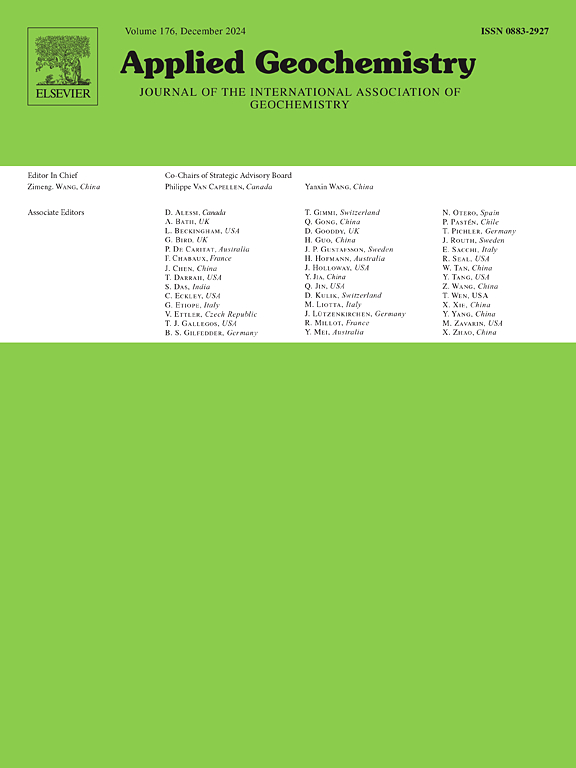火成岩侵入对晚中新世女川泥岩地球化学的影响:对日本秋田盆地非典型生烃的启示
IF 3.4
3区 地球科学
Q1 GEOCHEMISTRY & GEOPHYSICS
引用次数: 0
摘要
本研究从微观到大分子的尺度上考察了火成岩侵入的快速升温,特别是当侵入侵入与有机质沉积同时发生时,有机质的物理化学变化。秋田盆地女川组新近系硅质泥岩为研究对象,组内发育次火山岩和火山岩。因此,Yabase井的8个地层切割样品进行了Rock-Eval热解分析,然后选择靠近侵入体的3个样品和一个未侵入的样品进行进一步的生物标志物分析。一般来说,以Tmax为代表的干酪根和生物标记物对入侵引起的极端热应力有响应。虽然本井的Tmax非常低(Tmax<430°C),但该参数在侵入区显著升高,伴随着生产指数(PI)的增加,TOC和氢指数(HI)的降低。C23三环萜烯(TT) βα/αα、C24四环萜烯/C23 TT、Ts/(Ts + Tm)、C29和C30多环烷/藿烷、C31-C35高藿烷(HH) 22S/(22S + 22R)、C29甾烷20S/(20S + 20R)等与成熟度相关的饱和生物标志物比值在入侵邻近区域发生了微小的变化,甚至出现了逆转趋势。这些现象与干酪根成因、异构化失败和热降解三个主要因素有关。侵入的快速加热不足以产生异构反应,而耐热性更强的干酪根吸收热量生成沥青,包括更多的未成熟异构体。此外,该产沥青与该地区已产原油存在一定的关联性,也具有低成熟度特征。由此可见,火成岩侵入可以激活一个盆地的非典型含油气系统,尽管烃源岩与侵入事件同时或紧随其后沉积。本文章由计算机程序翻译,如有差异,请以英文原文为准。
Igneous intrusion effect on the geochemistry of Late Miocene Onnagawa mudstone: implication on the atypical hydrocarbon generation of Akita Basin, Japan
This study investigated the physio-chemical changes in organic matter, from micro-to macromolecular scale, due to rapid heating from igneous intrusion, particularly if intrusion emplacement occurred syn-contemporaneously with the organic matter deposition. The Neogene siliceous mudstone of the Onnagawa Formation in the Akita Basin is a suitable interval for this study, as subvolcanic and volcanic rocks were found within the formation. Hence, eight cutting samples of the formation from the Yabase well were subjected to Rock-Eval pyrolysis analysis, while three samples near the intrusion body and one unintruded sample were then selected for further biomarker analysis. Generally, kerogen, represented by Tmax, and biomarker proxies respond to the extreme thermal stress from intrusion. While the background Tmax is very low in our well (Tmax<430 °C), this parameter is significantly elevated in the intrusion zone, accompanied by an increasing production index (PI) alongside with reduced TOC and hydrogen index (HI). In contrast, slight changes, including reversal trend, in several maturity-related saturate biomarker ratios, such as C23 tricyclic terpanes (TT) βα/αα, C24 tetracyclic terpanes/C23 TT, Ts/(Ts + Tm), C29 and C30 moretanes/hopanes, C31–C35 homohopanes (HH) 22S/(22S + 22R), and C29 steranes 20S/(20S + 20R) were observed near the intrusion proximity. These phenomena are related to three major factors, which are kerogen-related generation, failed isomerization, and thermal degradation. Rapid heating from intrusion is insufficient to exhibit isomerization reaction, while kerogen, which is more thermally resistant, absorbs the heat and generates bitumen, including more immature isomers. Furthermore, this generated bitumen correlates with the produced oils in the area, which also inherit low maturity characteristics. Thus, it becomes evident that igneous intrusion could activate the atypical petroleum system in one basin, despite the source rock being deposited concurrently with or immediately after the intrusion event.
求助全文
通过发布文献求助,成功后即可免费获取论文全文。
去求助
来源期刊

Applied Geochemistry
地学-地球化学与地球物理
CiteScore
6.10
自引率
8.80%
发文量
272
审稿时长
65 days
期刊介绍:
Applied Geochemistry is an international journal devoted to publication of original research papers, rapid research communications and selected review papers in geochemistry and urban geochemistry which have some practical application to an aspect of human endeavour, such as the preservation of the environment, health, waste disposal and the search for resources. Papers on applications of inorganic, organic and isotope geochemistry and geochemical processes are therefore welcome provided they meet the main criterion. Spatial and temporal monitoring case studies are only of interest to our international readership if they present new ideas of broad application.
Topics covered include: (1) Environmental geochemistry (including natural and anthropogenic aspects, and protection and remediation strategies); (2) Hydrogeochemistry (surface and groundwater); (3) Medical (urban) geochemistry; (4) The search for energy resources (in particular unconventional oil and gas or emerging metal resources); (5) Energy exploitation (in particular geothermal energy and CCS); (6) Upgrading of energy and mineral resources where there is a direct geochemical application; and (7) Waste disposal, including nuclear waste disposal.
 求助内容:
求助内容: 应助结果提醒方式:
应助结果提醒方式:


